Taking a Hard Seat to Tibet: Pros, Cons, and Practical Tips
All Tibet trains offer both sleeper and seat carriages, with a significant difference in comfort and price. Among the available options—soft sleeper, hard sleeper, and hard seat—the hard seat is the cheapest option for traveling to Tibet, though it offers the least comfort.
If you're considering taking a hard seat, you probably want to know what to expect. That’s why we’re here: to walk you through what it’s like, its pros and cons, and how to prepare for an unforgettable journey in a hard seat.
CONTENT
What Is a Hard Seat Like on a Tibet Train?
Typically, there are four hard seat carriages on a Tibet train, each with 98 seats—two seats on one side of the aisle and three on the other, making a total capacity of 392 hard seat passengers per train. Overall, the hard seat carriages can be a bit crowded, especially during peak travel seasons.
Stepping into a hard seat carriage, you'll find that the seats are arranged in rows facing each other, with a small shared table in the middle. They are fixed and upright, slightly cushioned, and unable to recline. Besides, the seats are close together; that is to say, every passenger has limited space to stretch their legs, so you may feel cramped during a long-hour ride.
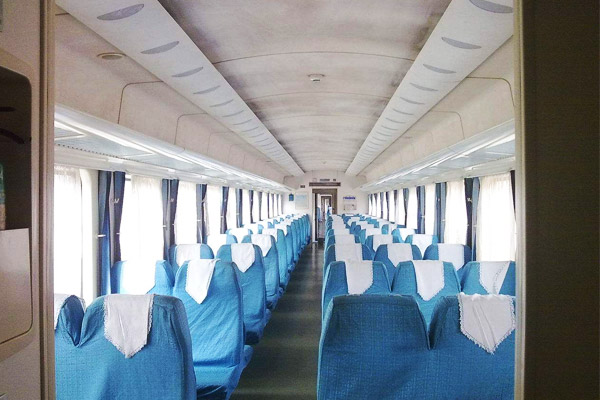 In hard-seat carriages of Tibet trains, seats are arranged two on one side and three on the other.
In hard-seat carriages of Tibet trains, seats are arranged two on one side and three on the other.What are the Pros and Cons of Taking a Hard Seat to Tibet?
1. Pros of Taking a Hard Seat to Tibet
Hard seats may not sound luxurious, but they do come with a few notable advantages—especially for travelers who are flexible, adventurous, or watching their budget. Here are some reasons why a hard seat might actually be a good choice for your Tibet train journey:
(1) Cheapest price
As the most affordable option, hard seat tickets usually cost about half the price of a hard sleeper and one-third of a soft sleeper. Currently, a hard seat to Lhasa costs between 224 RMB (departing from Xining) and 447 RMB (departing from Guangzhou), with the specific price depending on the travel distance. Additionally, the price may increase during peak travel seasons.
(2) More opportunities to interact with locals
Tibet trains stop at several stations along the way, where many local Tibetan passengers get on and off. For these locals traveling short distances, hard seats are undoubtedly the best choice. Thus, in hard seat carriages, you’ll have plenty of chances to meet local Tibetans—strike up a chat with them, and you can learn about their history, culture, and customs. These moments will undoubtedly add vivid color to your long, perhaps otherwise dull train journey.
2. Cons of Taking a Hard Seat to Tibet
Of course, lower prices come with limitations. A hard seat can test your patience and endurance, especially on longer trips. Below are some of the main drawbacks to keep in mind before booking your ticket:
(1) Long journey durations
Lhasa is located on the southwestern frontier of China, far from most inland cities. Due to the region’s complex terrain, the actual travel distance to Lhasa is much greater than the straight-line distance. Take Guangzhou as an example: the train journey to Lhasa covers nearly 5,000 kilometers and takes about 54 hours. This means you'll spend two nights and three full days on the train—a truly long journey.
(2) Physical discomfort
Hard-seat carriages offer very limited space, and the seats cannot be reclined. Sitting for a long time in the seat can easily lead to backaches, sore muscles, or numbness in the legs. Such discomfort will even worsen as the train climbs into high-altitude regions—especially when passing through the Tanggula Pass—where you may also experience altitude sickness, with symptoms such as dizziness, fatigue, and nausea
(3) Limited opportunities for a good rest
With limited space and uncomfortable seating, passengers in hard-seat carriages are only able to take short naps by leaning back against their seats. Moreover, since these carriages are open public spaces, they're likely to be disturbed by the surrounding light or noise when you're resting. As a result, it is really really difficult to get any real, extended sleep.
(4) Crowded and noisy environment
Hard-seat carriages are designed to carry as many people as possible at the lowest cost, so the seats are arranged in a compact way. During peak travel seasons, not only are all the seats fully occupied, but passengers often bring a lot of luggage—especially large or bulky items for long trips. These items are frequently stored in the aisles, under the seats, or on the overhead racks, which don’t offer much space to begin with. As a result, the space becomes even more crowded and noisy.
(5) Fewer amenities
Compared with sleeper carriages, passengers in hard sleeper compartments have less space, poorer privacy, fewer charging outlets, and no TVs. However, the conditions of other public facilities on the train are basically the same.
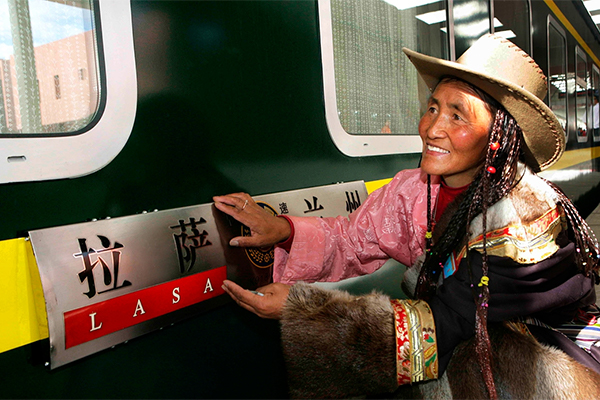 You may meet local Tibetan passengers on the Tibet train and have the chance to interact with them.
You may meet local Tibetan passengers on the Tibet train and have the chance to interact with them.Who Should Consider a Hard Seat?
Hard seats aren't as comfortable as hard or soft sleepers, so they’re not ideal for long journeys. However, if you're only traveling a shorter segment—say, from Xining to Lhasa (around 20 hours)—and you’re on a tight budget, then a hard seat can be a practical choice. It’s most suitable for budget-conscious travelers who are physically resilient and well-prepared for a basic ride.
What Facilities are Available in a Hard Seat Carriage?
1. Luggage storage
In each hard seat carriage on the Tibet train, there are about 50 cm wide overhead racks above the seats, which can hold medium-sized backpacks or suitcases up to 24 inches. Under your seats, there is also a small space suitable for small backpacks. Additionally, there is space near the doors at the ends of the carriage for large luggage.
2. Oxygen supply
All Tibet trains are equipped with two types of oxygen supply systems: a dispersion system and individual oxygen outlets. In hard seat carriages, these outlets are located under the seats. Simply connect the oxygen tube to the outlet, and you’ll receive enough oxygen to help relieve symptoms of altitude sickness.
3. Toilets and public sinks
There are two squat-style toilets at the end of the carriage. Although toilet paper is fully stocked before departure, it often runs out quickly, so be sure to bring enough of your own. Just outside the toilets, there are three basins with cold water, liquid soap dispensers, mirrors, and small trash bins where you can wash up.
4. Power sockets
Charging outlets in hard-seat carriages are very limited—typically only 2 to 3 sockets located near the washbasins or at the corridor junctions. Moreover, a few hours after the train departs, you may have to wait in line to use these sockets. So it’s a good idea to bring a power bank with you, just in case.
5. Hot water
Also at the end of each carriage, you can find a hot water dispenser, where passengers can get free hot water for tea, coffee, or instant noodles. Drinking enough water can help you better cope with the high-altitude environment.
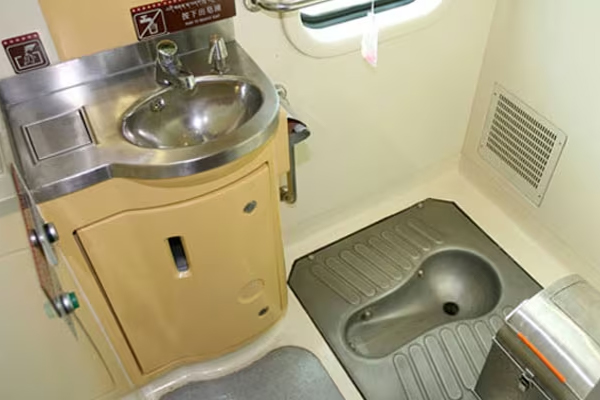 There are two squat-style toilets at the end of the hard-seat carriage.
There are two squat-style toilets at the end of the hard-seat carriage.How to Book a Hard Seat Ticket for a Tibet Train Trip?
Hard seats aren’t the most comfortable, but they still go fast during Tibet’s busy travel seasons. To avoid missing out, it’s recommended to book the tickets around 15 days ahead of your departure. You can either buy tickets online through the official 12306 website or app, or head to the ticket window at the departure station to get them in person.
Of course, we’re here to help with booking train tickets and applying for the Tibet Travel Permit too. In 2025, we guarantee soft sleeper tickets for each of our guests to ensure they have a comfortable journey.
Hard Seats vs. Sleeper Berths: Key Differences
The main differences between hard seats and sleeper berths lie in price, comfort, and level of privacy. You can check out the detailed comparison between them in the table below:
| Feature | Hard Seat | Hard Sleeper | Soft Sleeper |
|---|---|---|---|
| Seating/Berths | 98 seats, upright | 6 berths per compartment | 4 berths per compartment |
| Space | 40 cm, no reclining | 60 × 180 cm berths | 75 × 190 cm berths |
| Privacy | Low (open public areas) | Moderate (open compartments) | High (lockable door) |
| Amenities | Basic facilities (toilets, hot water, etc) | Bedding, sockets | Bedding, sockets, TV |
| Price | Lowest | Moderate | Highest |
| Suitable for | Short segment, tight budget | Sleeping comfort, budget-friendly | Maximum comfort and privacy |
Practical Tips for Taking a Hard Seat Journey on Tibet Trains
Bring a neck pillow, eye mask, and earplugs for those overnight hours. They will help you get as good a sleep as possible on the Tibet train.
For the toilets and wash areas, bring your own toilet paper, wet wipes, towel, and soap. Try to avoid peak usage times—typically early morning or after dinner.
If you feel altitude symptoms—headache, nausea—ask the staff for an oxygen tube right away.
Dress in layers, as the train passes through high-altitude regions where temperatures can vary significantly. Layered clothing makes it easy to add or remove layers as needed.
Occasionally getting up to stretch in the corridor or dining car can help relieve tired legs and refresh your mind.
Always keep your valuables within sight, especially in a crowded carriage.
Conclusion
Taking a hard seat to Tibet isn’t suitable for everyone. If you have a short journey, are on a tight budget, in good health, and well-prepared, then a hard seat can be a practical option. If not, we strongly recommend choosing a sleeper berth for a more comfortable experience.
Of course, no matter which class of ticket you choose for your trip to Tibet, we’re here to assist with train bookings, Tibet Travel Permit applications, and other related matters. So, if you have any questions about traveling to Tibet, feel free to contact us at any time.
Related Readings:
Recommended Tibet Train Small Group Tour Packages
-
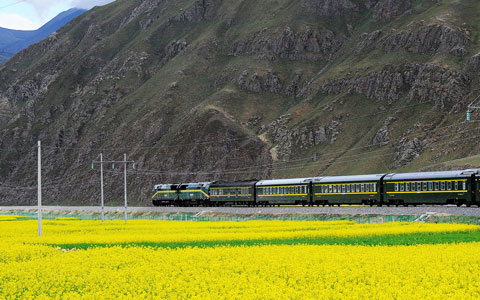 HOT5 Days Lhasa Small Group Tour by Tibet Train
HOT5 Days Lhasa Small Group Tour by Tibet TrainTibet train (from Xining) - Lhasa
Only From: USD599
View Details -
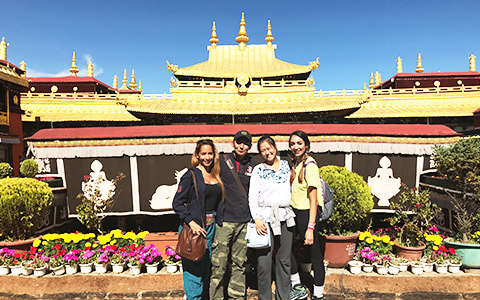 HOT6 Days Lhasa and Namtso Lake Small Group Tour with Tibet Train Experience
HOT6 Days Lhasa and Namtso Lake Small Group Tour with Tibet Train ExperienceTibet train (from Xining) - Lhasa - Namtso Lake - Lhasa
Only From: USD745
View Details -
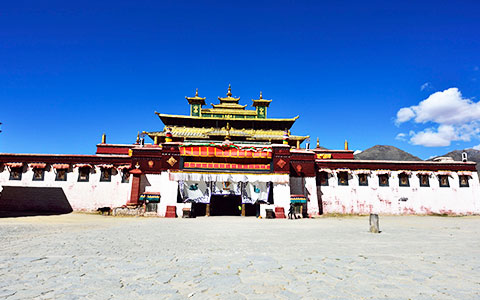 HOT7 Days Lhasa to Tsedang Small Group Tour with Tibet Train Experience
HOT7 Days Lhasa to Tsedang Small Group Tour with Tibet Train ExperienceTibet train (from Xining) - Lhasa - Tsedang - Lhasa
Only From: USD835
View Details -
 HOT6 Days Lhasa Three Major Monasteries Small Group Tour with Tibet Train Experience
HOT6 Days Lhasa Three Major Monasteries Small Group Tour with Tibet Train ExperienceTibet train (from Xining) - Lhasa - Drak Yerpa - Ganden - Lhasa
Only From: USD645
View Details
 BACK
BACK
0 Comment ON "Taking a Hard Seat to Tibet: Pros, Cons, and Practical Tips"